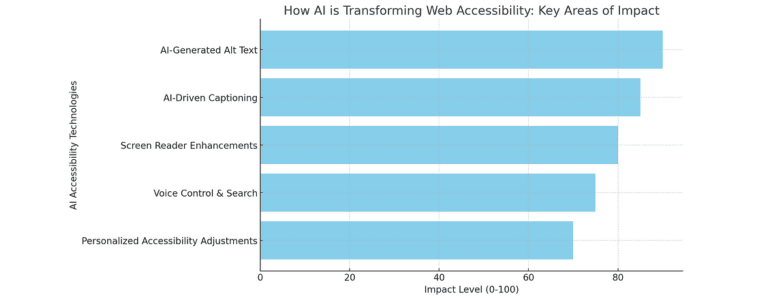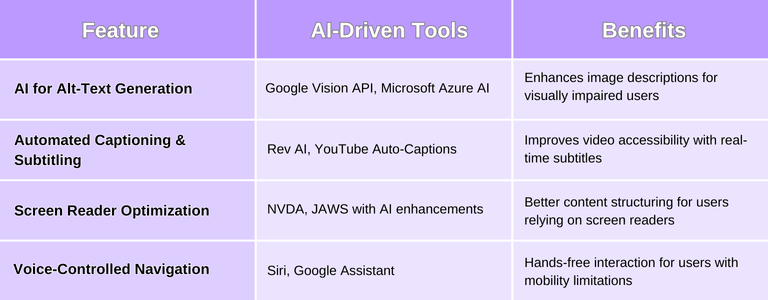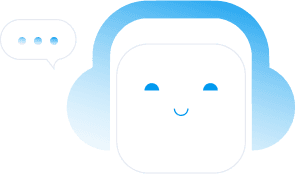Web for Everyone: Unlocking Digital Accessibility with the Power of AI
Nadiia Sidenko
2025-03-03
The internet is an essential part of daily life, providing access to information, services, and communication. However, millions of people with disabilities face barriers that limit their ability to fully engage with digital content. Understanding these challenges is the first step toward creating a more inclusive digital world.

The Critical Need for Web Accessibility: Why Inclusion Matters
Understanding the Diverse Needs of Users with Disabilities
A truly accessible web must cater to diverse disabilities, ensuring that all users can navigate and engage with digital content effectively.

For a deeper understanding of how AI is improving accessibility, check out this analysis from Siteimprove, which highlights AI-driven accessibility solutions.
The Legal and Ethical Imperative for Accessible Websites
Adhering to accessibility regulations is both a legal obligation and a moral responsibility. Compliance with WCAG guidelines, the Americans with Disabilities Act (ADA), and other global accessibility standards is crucial to creating equitable digital experiences.
Key reasons businesses should prioritize accessibility:
- Legal Compliance – Avoid lawsuits and ensure regulatory adherence.
- Ethical Responsibility – Promote inclusivity and equal access for all.
- Market Expansion – Reach a larger audience by removing digital barriers.
- SEO Benefits – Search engines favor accessible websites.
AI to the Rescue: Automating Accessibility and Breaking Barriers
AI is revolutionizing web accessibility by automating essential features and providing real-time adaptability.
How AI is Transforming Web Accessibility: Key Areas of Impact
1. Automatic Alternative Text (Alt-Text) Generation
- AI tools analyze images and provide contextually accurate alt-text
Example: Instead of "Image1.jpg," AI generates "A guide dog leading a visually impaired person across the street"
More details on AI-powered alt-text solutions from AccessiBe.
2. AI-Driven Captioning and Subtitling
- Real-time speech-to-text AI enhances video accessibility.
Platforms like YouTube and Zoom integrate AI-based captioning for inclusive content.
Learn more about how AI is improving video accessibility.
3. Intelligent Navigation and Screen Reader Compatibility
- AI enhances HTML structure and ARIA attributes, making screen readers more efficient.
4. Voice Control and Search
- Users with mobility impairments benefit from hands-free navigation through AI-powered voice search.
5. Personalized AI Adjustments
- AI dynamically adapts font size, contrast, and layout based on user preferences.

For more insights on AI in web development, visit AI Revolution in Web Development.
AI-Powered Accessibility Features in Action: Practical Examples

For ethical considerations of AI-driven design, read Ethics in AI-Driven UI/UX Design.
Choosing and Implementing AI Accessibility Solutions: A Practical Guide
Evaluating AI Accessibility Tools and Services
When selecting AI-powered accessibility solutions, consider the following criteria:
- Accuracy and Reliability – Ensure AI-generated content maintains contextual integrity
- Ease of Integration – Tools should seamlessly integrate with existing platforms
- Customization Options – AI must allow for manual overrides and fine-tuning
- Cost and Scalability – AI solutions should be affordable and scalable for future growth
Best Practices for Integrating AI Accessibility into Web Development
- Conduct an accessibility audit before implementing AI.
- Select AI solutions that align with WCAG guidelines.
- Test AI-generated content with real users and make adjustments.
- Continuously update and refine AI models to improve accuracy.
FAQ: Common Questions on AI and Web Accessibility
Does AI make websites more accessible?
Yes, AI significantly enhances accessibility by automating tasks like alt-text generation, video captioning, voice commands, and screen reader optimizations. AI-driven solutions improve user experience for people with disabilities and help businesses comply with accessibility regulations.
What AI tools are available for web accessibility?
Some popular AI-driven accessibility tools include:
- Google Vision API – Generates automatic image descriptions
- Rev AI – Provides real-time captions and subtitles
- NVDA & JAWS – Optimized with AI for screen reader compatibility
- Google Assistant & Siri – Enable voice-controlled navigation
Is AI captioning accurate for accessibility?
AI-powered captioning tools have improved significantly, but accuracy depends on factors like audio quality, speaker accents, and background noise. Some AI solutions allow manual editing to improve captions.
How much does AI accessibility cost?
The cost of AI accessibility solutions varies. Some tools are free, while enterprise solutions may require monthly subscriptions or licensing fees. Investing in AI-driven accessibility often leads to higher ROI by reaching a broader audience and improving user experience.
How will AI change web accessibility standards?
AI is shaping the future of accessibility by making digital content more adaptive and personalized. As AI technology advances, standards like WCAG may incorporate AI-based recommendations to enhance compliance and inclusivity.

Conclusion
AI is transforming web accessibility, making the internet a more inclusive space. By leveraging AI-powered solutions like automated alt-text generation, real-time captioning, intelligent navigation, and voice control, businesses can ensure compliance, reach wider audiences, and foster a digitally inclusive environment. However, AI must be integrated thoughtfully, balancing automation with traditional accessibility best practices to create a truly equitable web experience for all.